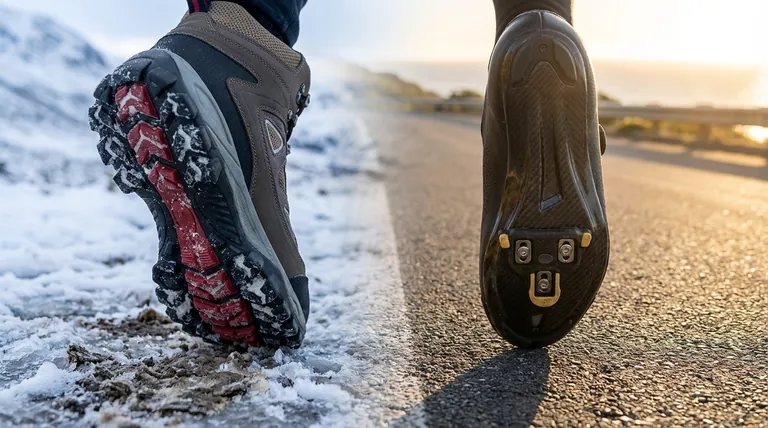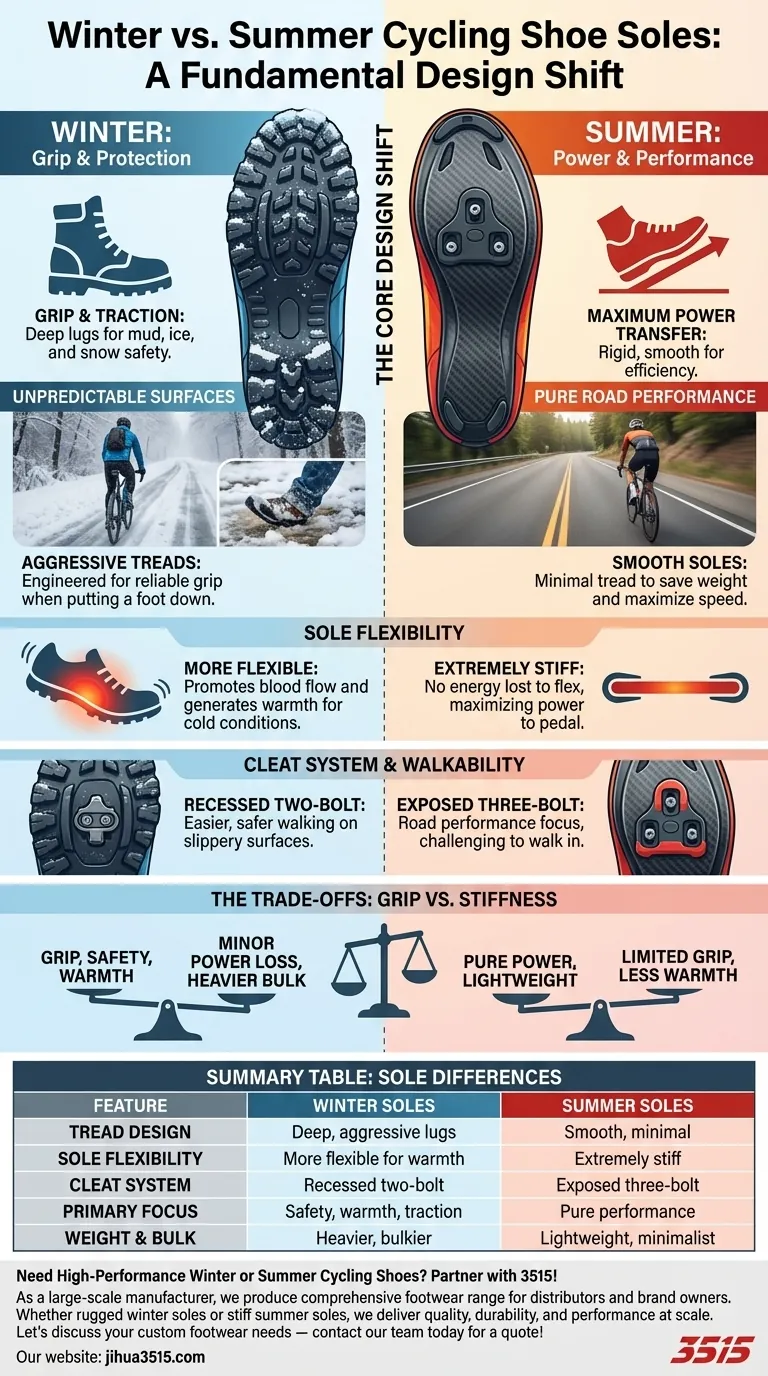In short, winter cycling shoe soles are fundamentally different in two key ways: grip and flexibility. Unlike the smooth, rigid soles of summer shoes designed for maximum power transfer, winter soles feature aggressive, rugged treads for traction on slippery surfaces and are often more flexible to promote circulation and warmth.
The core design philosophy of a winter cycling shoe sole shifts from pure performance to practical protection. It sacrifices the absolute stiffness prized in summer for the essential winter requirements of grip, safety, and warmth.

The Core Design Shift: From Power to Protection
The sole of a summer racing shoe is a tool for a single job: transferring every possible watt of power from your leg to the pedal. The sole of a winter shoe has a much broader, more complex set of responsibilities.
Grip and Tread for Unpredictable Surfaces
The most obvious difference is the outsole material and pattern. Summer road shoes often have very smooth soles with minimal rubber tread to save weight.
Winter shoes, in contrast, feature deep, aggressive lugs made from softer rubber compounds. This design is engineered to provide reliable grip when you inevitably have to put a foot down on mud, ice, or snow.
This is especially critical for mountain biking or gravel riding, where dismounting is common, but it also provides a significant safety benefit for road cyclists at icy intersections.
The Unexpected Role of Sole Flexibility
While summer shoes are marketed on their extreme stiffness for power efficiency, many winter shoes are intentionally designed with more flexibility.
This may seem counterintuitive, but a more flexible sole allows for greater foot movement and muscle flexion while pedaling and walking.
This subtle movement is crucial for stimulating blood flow and generating small amounts of heat, helping to keep your feet warmer in cold conditions than a completely rigid, unmoving platform would.
Compatibility and Walkability
The rugged design of winter soles almost always incorporates a recessed, two-bolt cleat system (like Shimano SPD).
This system, common in mountain biking, places the cleat within the tread of the sole. This makes walking far easier and safer on slippery surfaces compared to the exposed three-bolt cleat systems found on most high-performance summer road shoes.
Understanding the Trade-offs: Grip vs. Stiffness
Choosing a winter shoe sole involves balancing competing priorities. The features that make it effective in the cold come with inherent compromises.
The Cost of Flexibility: Power Transfer
The primary trade-off is power transfer. A stiffer sole creates a more efficient lever for pushing down on the pedal.
The added flexibility in a winter shoe means a tiny fraction of your energy is lost to sole flex with each pedal stroke. For most winter training, this is an imperceptible and worthwhile price to pay for warmth and comfort.
The Weight and Bulk Penalty
Robust rubber lugs, insulation, and waterproofing materials all add up. Winter cycling shoes are significantly heavier and bulkier than their minimalist summer counterparts.
This additional weight is a necessary consequence of building a shoe designed for protection and durability rather than pure, lightweight performance.
Making the Right Choice for Your Winter Riding
The ideal sole depends entirely on the conditions you face.
- If your primary focus is cold but dry road riding: You can prioritize a stiffer sole, as extreme off-road grip is less critical and you will benefit from better power transfer.
- If your primary focus is mountain biking, gravel, or riding in wet and icy conditions: A rugged, more flexible sole with aggressive tread is non-negotiable for safety and warmth.
- If your primary focus is commuting: Prioritize a sole with recessed cleats and excellent tread for safe and easy walking when you are off the bike.
Ultimately, choosing the right sole means prioritizing safety and warmth, ensuring you can ride confidently through the harshest conditions.
Summary Table:
| Feature | Winter Cycling Shoe Soles | Summer Cycling Shoe Soles |
|---|---|---|
| Tread Design | Deep, aggressive lugs for grip on mud, ice, and snow | Smooth, minimal tread for weight savings |
| Sole Flexibility | More flexible to promote blood flow and warmth | Extremely stiff for maximum power transfer |
| Cleat System | Recessed two-bolt (e.g., SPD) for walkability and safety | Exposed three-bolt for road performance |
| Primary Focus | Safety, warmth, and traction in harsh conditions | Pure performance and power efficiency |
| Weight & Bulk | Heavier and bulkier due to insulation and rugged materials | Lightweight and minimalist |
Need High-Performance Winter or Summer Cycling Shoes? Partner with 3515!
As a large-scale manufacturer, 3515 produces a comprehensive range of footwear for distributors, brand owners, and bulk clients. Our production capabilities encompass all types of shoes and boots, including specialized cycling footwear designed for any season. Whether you need rugged winter soles for superior grip and warmth or stiff summer soles for optimal power transfer, we deliver quality, durability, and performance at scale.
Let’s discuss your custom footwear needs — contact our team today for a quote!
Visual Guide

Related Products
- Safety Footwear Wholesale Manufacturer for Custom OEM/ODM Production
- Factory Direct Wholesale Rain Boots Durable Waterproof & Fully Customizable
- Factory-Direct Wholesale Canvas Boots with High-Traction Rubber Soles
- Premium KPU Injection Athletic Style Safety Shoes
- Wholesale Safety Footwear Manufacturer for Bulk & Custom OEM Orders
People Also Ask
- Is safety-toe as good as steel toe? Choose the Right Protection for Your Job
- What are the differences between steel toe, composite toe, and alloy toe Wellington boots? Choose the Right Safety Toe for Your Job
- What do heavy duty boots do? Protect Your Feet in Demanding Work Environments
- What cultural and environmental considerations are tied to wearing shoes indoors? Balance Hygiene, Tradition, and Foot Health
- How do safety shoes contribute to cost savings for companies? A Strategic Investment in Risk and Cost Management



















